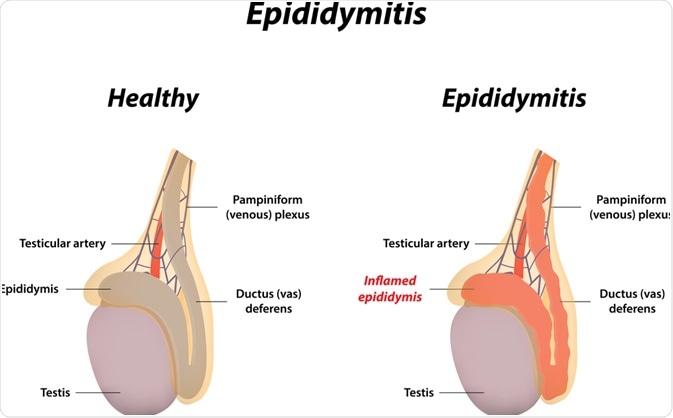Symptoms of epididymitis must be recognized as soon as possible to enable early treatment and avoid worsening of the condition.
This article details the significant signs and symptoms of epididymitis to be recognized and diagnosed so that treatment decisions can be made. It is also important to be aware of the signs of complications associated with the condition.
Visible Signs
The epididymitis signs are visible upon physical examination of the affected area and can help to recognize epididymitis and make decisions regarding the appropriate treatment.
Inflammation of the scrotum is the characteristic sign of epididymitis. This usually presents as swelling, redness, and warmth of the scrotal area.
There is often a lump on the affected side of the testicle that can be identified, which is caused by the accumulation of fluid and is referred to as hydrocele. Additionally, the lymph nodes in the groin commonly enlarge as a result of the condition.
Discharge from the penis is also commonly associated with epididymitis, particularly in patients with the condition caused by a sexually transmitted infection (STI) such as chlamydia or gonorrhea. Blood in the semen may also be present.
Some patients have a slightly raised temperature and chills associated with an infection in the body, either in the urinary tract or sexual organs.

Epididymitis. Image Credit: joshya / Shutterstock
Patient Symptoms
Patients with the condition may report epididymitis symptoms when they present to a health professional for advice.
The most common symptom is a pain in the testicles, which is usually focused on one side but may be bilateral. This is also sometimes described as a pressure or tenderness in the area. The pain often worsens during certain activities, such as passing urine or during bowel movements, intercourse or ejaculation. The pain or discomfort may affect a larger area, including the lower abdominal and pelvic region.
Some epididymitis patients report an increased frequency and urgency of urination, particularly in patients with the condition caused by a urinary tract infection.
Chronic Epididymitis
Chronic epididymitis involves the symptoms of the condition that recur or last for at least weeks. Chronic epididymitis symptoms are often less pronounced than in the acute condition and may present more gradually.
Complications
It is important that any male patient experiencing pain or swelling in the scrotal or groin region is encouraged to discuss the symptoms with a health professional. This helps to prevent the progression of the condition and the presentation of complications.
If epididymitis is not diagnosed in a timely manner, it can cause rare complications, such as testicular atrophy, scrotum fistula, testicular infarction, and infertility.
Additionally, a differential diagnosis to exclude other health conditions that can have potentially severe outcomes, such as testicular torsion, is essential and is done based on presenting symptoms and results from ultrasound tests. In particular, the symptoms tend to present suddenly in testicular torsion but more gradually over a few days in epididymitis.
References
Further Reading